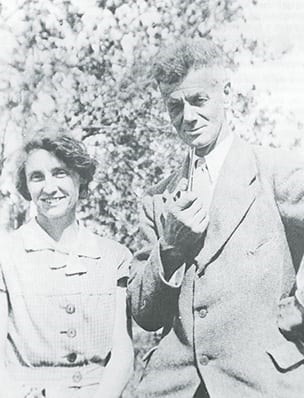BY CATHERINE B. RICE Pelham Historical Society
The members of the Goldring family were always interested in progress and improvement. They were also firm supporters of church and community and the appreciation of history and heritage. They were good friends of all who lived in the neighbourhood, which to them extended beyond geographical borders. During the Second World War, each one offered his or her assistance for the good of the country.

Mr. Goldring was enthusiastic about protecting the environment long before the average person gave it much thought. He and Mrs. Goldring often took a drive through the country, noting areas which were neglected or misused. By means of letters to the newspapers, Mr. Goldring urged the readers to respect their environment, and to mend what was wrong before it was too late. In an article written on January 22, 1955, he described the drives and trails that would make our area more beautiful and encourage visitors. About one, he said, “I want a road running along a stream of clear water coming down in a series of waterfalls from Lake Gibson,and planted on each side with flowering trees such as hawthorns and dogwoods.”
He mourned the pollution of rivers, the smoke-laden atmosphere, and garish advertising,, but the mourning was not an end in itself. He conveyed his thoughts to others, and hoped for a good response from the inhabitants of Pelham. He considered that the Niagara Escarpment should be a parkway, with young people developing an active interest in protecting it. He pleaded for the life of our trees, so that no community would be deprived of its rightful heritage in the way of growing things. He could not understand why “highways should be bare and drab,” and felt that rural roads should be kept in shape with no billboards, and with trees bordering them once again.
When Mr. and Mrs. Goldring bought their home in Effingham, it was a mixed farm where the topsoil was washing down the steep, bare hillsides. When they took up residence in 1934, Mr. Goldring began changing it to a fruit farm, sparing no effort to improve the situation. He planted hundreds of forest trees on the hillsides, so ending the persistent erosion, and improved the soil of the farm by cultivating, fertilizing and underdraining. Many black walnut trees were placed in the former pasture fields, and black locusts along the roadside.
On June 28, 1973, the Niagara Peninsula Conservation Authority wrote Mr. Goldring a very complimentary letter stating that they were most appreciative of his work and leadership in conservation over these many years.
Mr. Goldring's wish for the perpetuation of trees lives on. When Mr. Lou Bowman was the principal of E.L. Crossley Secondary School,, he leased seven acres on the east side of the Goldring farm, dedicating the use of it to conservation, with pupils from his school annually planting trees under his direction. The Carolinian forest is represented, as tulip trees are thriving on the site, along with valuable walnut trees which actually grow to a height of 40 or 50 feet before bearing any branches. Visits to the Goldring Woodlot by elementary school students are now part of the programme of the St. John's Outdoor Studies Centre.
Originally published in the Pelham Historical Society Calendar, 1996



